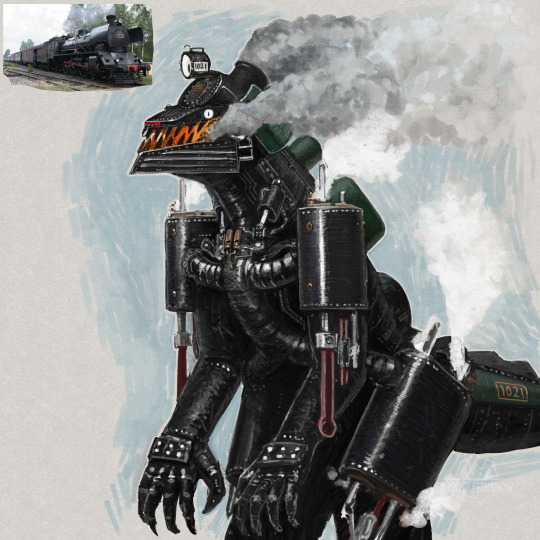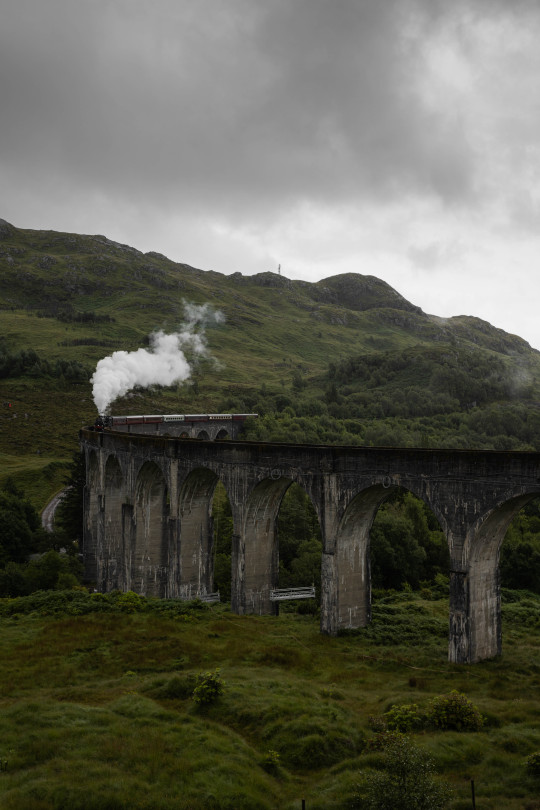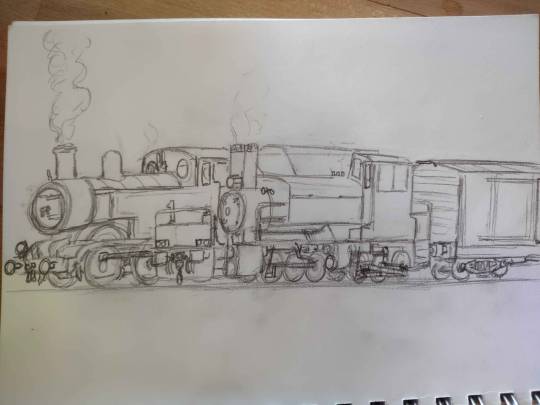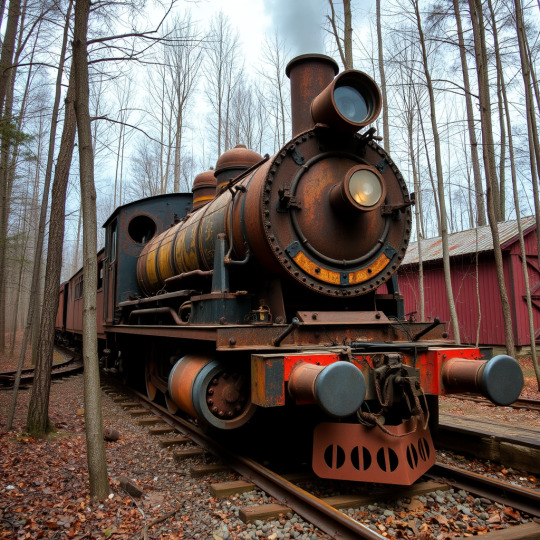#steam train
Explore tagged Tumblr posts
Text








SAXONIA – Die erste deutsche Dampflokomotive
Die SAXONIA war mehr als nur eine Lokomotive – sie war ein Meilenstein der deutschen Technikgeschichte. 1838 vom sächsischen Ingenieur Johann Andreas Schubert konstruiert, war sie die erste in Deutschland gebaute funktionsfähige Dampflokomotive. Gebaut wurde sie in der Maschinenbauanstalt Übigau bei Dresden – ohne konkreten Auftrag, aber mit großem Pioniergeist.
Ihr historischer Auftritt fand 1839 auf der neu eröffneten Leipzig-Dresdner Eisenbahn statt. Während britische Maschinen den Eröffnungszug führten, rollte Schuberts SAXONIA hinterher – als mutiger Beweis dafür, dass auch deutsches Ingenieurwesen auf der Schiene bestehen konnte. Technisch war sie ihrer Zeit voraus: Mit zwei gekuppelten Treibachsen und einer Laufachse bot sie mehr Stabilität als viele ihrer englischen Vorbilder. Ihre Höchstgeschwindigkeit lag bei rund 50 km/h – beeindruckend für die Zeit.
Nach knapp zehn Jahren im regulären Dienst wurde die SAXONIA 1849 ausgemustert und verschrottet. Doch ihr Name blieb: Sie gilt als Symbol für den Beginn des deutschen Lokomotivbaus und ebnete den Weg für eine eigenständige Eisenbahnindustrie.
Zum 150-jährigen Jubiläum der Strecke Leipzig–Dresden entstand 1988 in der DDR ein funktionsfähiger Nachbau der SAXONIA, der bis 2011 sogar unter Dampf fuhr. Heute ist diese Replik im Verkehrsmuseum Dresden ausgestellt – ein faszinierendes Zeugnis des industriellen Aufbruchs im 19. Jahrhundert.
Die SAXONIA ist bis heute ein fester Bestandteil der deutschen Eisenbahngeschichte – nicht nur als technische Errungenschaft, sondern auch als kulturelles Erbe. Wer in Dresden steht, sollte sich die Gelegenheit nicht entgehen lassen, diesem Stück lebendiger Geschichte persönlich zu begegnen.

SAXONIA – the first German steam locomotive
The SAXONIA was more than just a locomotive – it was a milestone in the history of German engineering. Designed in 1838 by the Saxon engineer Johann Andreas Schubert, it was the first operational steam locomotive to be built in Germany. It was constructed in the Übigau engineering works near Dresden – without a specific order, but with a great pioneering spirit.
Its historic debut took place in 1839 on the newly opened Leipzig-Dresden railway. While British locomotives led the inaugural train, Schubert's SAXONIA followed behind – a bold demonstration that German engineering could also hold its own on the rails. It was technically ahead of its time: with two coupled driving axles and a trailing axle, it offered more stability than many of its English role models. Its maximum speed was around 50 km/h – impressive for the time.
After just under ten years in regular service, the SAXONIA was taken out of service and scrapped in 1849. But its name remained: it is considered a symbol for the beginning of German locomotive construction and paved the way for an independent railway industry.
To mark the 150th anniversary of the Leipzig–Dresden line, a functional replica of the SAXONIA was built in the GDR in 1988, which even ran under steam until 2011. Today, this replica is on display at the Dresden Transport Museum – a fascinating testimony to the industrial awakening of the 19th century.
The SAXONIA remains an integral part of German railway history to this day – not only as an engineering achievement, but also as a cultural heritage. Anyone visiting Dresden should not miss the opportunity to see this piece of living history in person.
#dampflokblog.de#SAXONIA#Dresden#steam train#railway#dampflok#eisenbahn#stoom locomotief#steam locomotive#локомотив#lokomotywa#locomotive à vapeur#鉄道
40 notes
·
View notes
Text




Steaming through Harz, Germany
tom_juenemann
#harz mountains#snow#winter wonderland#photography#snowfall#travel#steam train#trains#curators on tumblr
1K notes
·
View notes
Text

The Great Train Graveyard in Uyuni, Bolivia is a unique tourist attraction in addition to the famous salt flats and red lakes. The area is home to a collection of abandoned, vintage trains that were originally intended to expand the transportation network in the early 19th century. However, due to technical challenges and conflicts with local indigenous communities, the project was never completed. The trains were later used to transport minerals to port cities, but when the mineral resources depleted in the 1940s, the miners left and the trains were left to deteriorate in the desert. Over time, exposure to salty winds has caused the trains to corrode, creating the fascinating landscape of the Great Train Graveyard that exists today.
Credits: Keith Alexander
2K notes
·
View notes
Text

Steam power
10K notes
·
View notes
Text

The Jacobite at Glenfinnan Viaduct
#Glenfinnan viaduct#glenfinnan#scotland#scottish highlands#harry potter#hp fandom#original photographers#photographers on tumblr#landscape#nature#britain#adventure#trees#harry potter fandom#architecture#viaduct#bridge#steam train#Jacobite#mountians#hills
885 notes
·
View notes
Text
Steamy Power Locomotive 🚂
#steam locomotive#locomotive#old trains#amazing#video#amazingly beautiful#steam train#strange#weird#my video#omg#steampunk#trains
2K notes
·
View notes
Text

Scotland’s Most Scenic Train Journeys
Scotland’s railways offer more than just transport—they provide some of the most breathtaking views in the world. Whether you’re gliding past rugged mountains, shimmering lochs, or dramatic coastlines, these scenic train journeys make the journey as remarkable as the destination.
#scotland#scottish#travel#scenery#landscape#nature#travel inspiration#scottish highlands#landscape photography#trains#scenic trains#glenfinnan viaduct#steam train
212 notes
·
View notes
Text

NWR No.1 and SLYM No.11513 at a dual gauge interchange just outside of the city center.
SLYM No.11513 is an Advanced Steam Locomotive native to Gymnome--a coal-burning steam engine operating at high pressure, with technological improvements to allow it to rival the efficiency and ease of use of a diesel locomotive, such as electronic controls, compound expansion of steam, a gas producer combustion system firebox, dual exhaust, and automatic firing and oiling. 11513 was built some time in the 2340s, and survives to 2381 as a museum piece.
NWR No.1 is a much older locomotive and from another planet altogether, built 1915 for the LBSC railway as a one-off prototype for a six-coupled shunter to replace the aging Terriers and to supplement the much larger E2-tanks. NWR No.1 made it to the North Western Railway not long after it was built, having been allocated there for the war effort. It is not clear how a locomotive built 465 years in the past on planet Earth made it intact to Gymnome, nor how its gauge perfectly matched Goo'iw Broad Gauge, at least not without invoking some kind of universe-spanning magic railroad, or perhaps the notion that this is all a simulation being run in some kind of virtual reality in some alien starship.
(no this isn't canon.)
Artist's notes:
Earlier today I doodled this in my sketchbook.

And when I got home i decided, hey, I have my Thomas 3D model, and I have the game model of the Advanced Steam Tank Engine... why not actually stage them together and draw them to-scale. The size difference is greater than I expected--partly I think this is because the Thomas gauge-1 prop was not designed with scale in mind, so it's bigger than British Railways loading gauge. Granted, they are at different gauges (standard gauge versus roughly meter-ish gauge), but the loading gauge on the advanced steam engine is very wide.
My first attempt at the drawing was from a very different angle:

But I quickly realized that you can't actually see the Advanced Steam Engine's wheels, and that's a major design aspect.

So i chose a different angle.


I constructed the dual gauge track before anything else.

And before long (the better part of 2 hours) I had the line art finished.
The Advanced Steam Engine ended up being a hybrid between the original illustration I did of it months ago, and the game model--with most of the geometry accurate to the game model, but with the subtler detailing of the illustrated version.
Thomas was meant to be a sort of hybrid of the Gauge 1 Prop from the TV series and a realistic loco. I prioritized the geometry and simplicity of the gauge 1 prop in most respects, but added details below the running board, in particular brake rigging, sanding gear, and these blade-like protrusions of the frames which i'm pretty sure are some kind of debris deflector, a british version of a cowcatcher. There's also snifters on the cylinder saddle, and the whistle is made of two different lengths to justify Thomas' multi-tone whistle.

The original background was going to be this marshland with (electricity-generating) windmills in the background, a callback to that first shot in the Thomas & Friends opening credits, but I hated how it felt like the middle of nowhere, so I introduced the retaining wall and an alien city scene.

British steam engines are generally given very shiny liveries which reflect the environment in interesting ways, so I made sure to do that justice, using a GWR 14xx autotank as reference.

By contrast, the Advanced Steam Tank Engine is kept in a more workwormlike condition, with a somewhat faded matte paint work and a fair amount of grime.

The original illustration of the advanced steam engine, for comparison.

Finally, a version with faces.
#advanced steam engine#tank engine#thomas the tank engine#ttte#train puzzle#mellanoid slime worldbuilding#train#steam train#ttte thomas#steam locomotive#worldbuilding#art#digital art#crossover
178 notes
·
View notes
Text

old steam engine
#beauty#landscape#outdoors#peaceful#fantasy#nature#serene#train#steam engine#locomotive#steam train#steam locomotive
379 notes
·
View notes
Text




Union Pacific Bigboy 4014 at Linwood Kansas on its way to Topeka KS
taken 10/17/24
#photography#trains#steam locomotive#UP#union pacific#kansas#locomotive#steam train#steam engine#railroad#big boy 4014#up 4014#4014
314 notes
·
View notes
Note
i have a very odd request: can jesus hold a steam train and the lesbian flag at the same time? it’s an inside joke and i need to show it to someone-
Today, Jesus is holding:
A steam train and a lesbian flag

228 notes
·
View notes
Text

Dampflokomotive 99 5902 der Brockenbahn (2017)
Steam locomotive 99 5902 of the Brockenbahn (2017)
Locomotive à vapeur 99 5902 de la Brockenbahn (2017)
#dampflokblog.de#99 5902#steam train#railway#dampflok#eisenbahn#stoom locomotief#steam locomotive#локомотив#lokomotywa#locomotive à vapeur#Brockenbahn#鉄道#lokomotiva#locomotive#Eisenbahn#stoomtrein
25 notes
·
View notes
Text

"We've no money to mend you... to the back of the shed you'll go"
300 notes
·
View notes
Text

Terence Cuneo (1907-1996) - The 'Flying Scotsman', 4472
Oil on canvas. Painted c.1972.
29.9 x 40.2 inches, 76 x 102 cm. Estimate: £30,000-50,000.
Sold Sworders, Stansted Mountfitchet, Essex, 1 Oct 2024 for £29,000 + B.P.
The Flying Scotsman, still in service, is the most iconic steam locomotive in the UK.
255 notes
·
View notes
Text





On 24th February 1923, the world famous steam train, the Flying Scotsman, went into service.
The first train to officially reach speeds of 100 mph and more, the Flying Scotsman is 102 years old today.
The Flying Scotsman is arguably the most famous locomotive in the world. Originally built in Doncaster and started life on the London and North Eastern Railway in 1923. It was named the Flying Scotsman after the London to Edinburgh service which started daily at 10am.
Designed by Sir Nigel Gresley, it was the first steam train to ever reach speeds of 100mph. In 1928, it was redesigned with a new type of corridor which meant a new crew could take over without the train stopping - reducing journey times from London to Edinburgh by eight hours.
The locomotive starred in The Flying Scotsman feature film released in March 1930, one of Britain’s first films with a ‘talkie’ soundtrack.
When it was first built, the Flying Scotsman was apple green, but it was repainted black during the war, in common with all railway stock. It was later blue when the railways were nationalised until it went out of service in 1963.
The locomotive was bought and repaired by businessman William McAlpine in the Eighties and went on a tour of Australia, clocking up 422 miles - the longest ever non-stop run by a steam locomotive.
In the 90s, the Flying Scotsman was once part-owned by record producer Pete Waterman.
After a successful campaign, the locomotive was once more returned to public ownership in 2004. In its latest form, it is back to its classic green and is officially known as No. 60103.
In 2024, almost 320,000 people viewed, climbed aboard or took a ride on Flying Scotsman
73 notes
·
View notes
Text

The Jacobite, Glenfinnan Viaduct
#the jacobite#jacobite#steam train#steam engine#steam locomotive#locomotive#train#railways#original photographers#photographers on tumblr#landscape#nature#britain#trees#adventure#scotland#glenfinnan#glenfinnan viaduct#architecture#scottish highlands#harry potter fandom#harry potter#hp fandom
523 notes
·
View notes